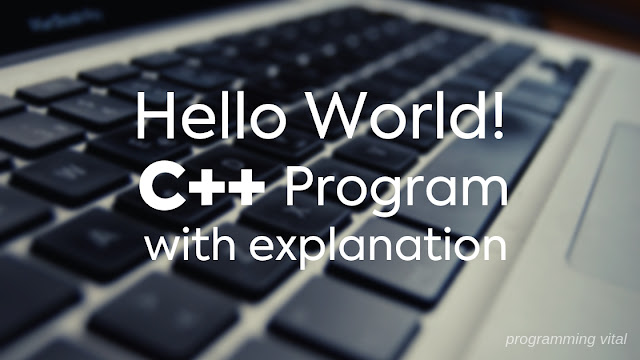C++comments in c++coutCPPcpp programscpp tutorialsfunctiongetch()hello world programhello world program in c++pre-processor directivereturn
A Simple Hello World C++ Program to understand basics of C++ Programming
Here is a Simple C++ Program with Explanation which Prints Hello World! Welcome to C++ on the Screen.
1.
// A Simple C++ Program
2.
#include <iostream>
3.
#include <conio.h>
4.
using namespace std;
5.
// Function main begins
program execution
6.
int main()
7.
{
8.
cout << "Hello World!";
9.
cout << "\nWelcome to C++!";
10.
return 0;
11.
_getch();
12.
}
Output
Hello
World!
Welcome to C++!
Comment: (Line 1 & 5)
// A Simple C++ Program
The line beginning with a double backslash (//) is a
comment. Commenting on your program makes it readable for a large number of
people. Consider you are making a program, and later you send it to your
friend. Your friend might feel difficult to understand your code. Here
commenting will benefit both of you.
Pre-Processor Directive: (Line 2 & 3)
#include <iostream> & #include <conio.h>
Before the actual compilation, the preprocessor is a program
invoked by the compiler that modifies the source code. This type of
modification is done according to the preprocessor directives that we include
in our source files. The directives all start with a hash sign (#). So they are
easily distinguished from normal programming code. The first directive we’ll
look at is #include, which inserts the contents of a specific file into the
current one. If the filename is enclosed between angular brackets <>, the
compiler will search for the file in the default directory where it is
configured to look for the standard header files. If we instead specify the
filename between double-quotes, the compiler first searches for the file in the
same directory as the source file, and in case it is not there it will then
search among the standard header files.
using namespace std: (Line 4)
using namespace std;
Std is the standard namespace. Cout, cin and many other
things are defined in it. (This means that one way to call them is by using
std::cout and std::cin.) The keyword using technical means, use this whenever
you can. It refers, in this case, to the std namespace.
Function Definition: (Line 6 – 12)
This portion consists of two parts; Function Header and
Function Definition (Line 7-12).
Function Header (int main())
Function Header contains return Data-type (int), Function
Name (main) and input(s) in parentheses. Return data-type should be according
to what value the function will return. It may be int, float or a character. A
function name is an identifier, and it should be named carefully.
Read this article to name an identifier.
Read this article to name an identifier.
Its syntax would be
return data-type functionName(inputs)
Function Body (Line 7-12)
All the code enclosed in braces {} is called function body.
Function body defines the work of the function.
cout: (Line 8 & 9)
Cout is an object lying in standard namespace. It is used
for printing something on the console window.
return statement: (Line 10)
Return statement used to return something from the function.
Here Return 0 means successful execution and return 1 indicate unsuccessful
execution.
getch(): (Line 11)
_getch() or getch() is a function lying in conio.h header
file. It is mostly used in the Visual Studio. Its function is that: It waits
for the user to press any key for the output screen to disappear.
About Main Function:
The main function is a user-defined function, as it depends
upon the user what he has written inside it. Execution of any C++ programs
always starts from the main function. It is the main point of any C++ Program.
Without it, no program will run, since execution begins from the main function
and also ends on it. There must be the main function in every program.
Thanks for reading. If you like this article then give a Thumbs up. Don't Forget to write your opinion in the comment box and if you think that this article will help any of your friends then do share this article.
Thanks for reading. If you like this article then give a Thumbs up. Don't Forget to write your opinion in the comment box and if you think that this article will help any of your friends then do share this article.
Note: C++ is a case sensitive programming language. Make sure you use correct spelling and capitalization. Here in this article, there may be mistakes because it follows basic English rule to be written. So Kindly follow the method told in the program.


1 comments
Conio... 🤬
ReplyDeletePOSIX rules !